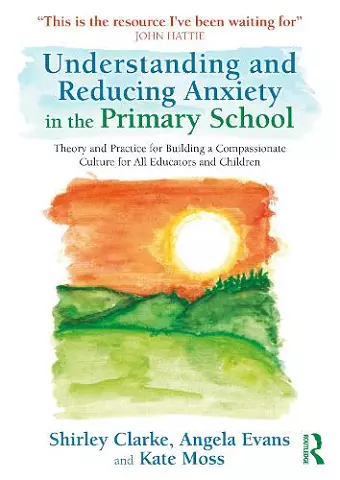Understanding and Reducing Anxiety in the Primary School
Theory and Practice for Building a Compassionate Culture for All Educators and Children
Angela Evans author Kate Moss author Shirley Clarke author
Format:Paperback
Publisher:Taylor & Francis Ltd
Published:19th Jul '24
Should be back in stock very soon
This paperback is available in another edition too:
- Hardback£145.00(9781032593791)

Everyone working in education, and beyond, is fully aware of the current mental health crisis for pupils. Understanding and Reducing Anxiety in the Primary School combines the expert knowledge of a specialist in formative assessment, a child and adolescent psychotherapist and an outstanding headteacher to address how we may tackle this issue and improve the wellbeing of children in our schools. Formative assessment, one of the key techniques explored within this book, has explicit links with reducing anxiety: raising children’s belief in their ability to achieve and giving them clear frameworks of learning intentions and success criteria as well as in-the-moment feedback so that they are reassured and able to voice any worries while they are working.
Written in a practical and accessible manner, the authors unpack the psychology behind issues related to students’ mental health and provide illustrative, relatable anecdotes and helpful strategies to support a positive, anxiety-free learning environment.
The book is divided into four distinct sections:
- Why is everyone so anxious and what can we do about it?
- Understanding and dealing with extreme behaviour
- Supporting the learning to reduce anxiety
- Creating a containing and compassionate school
This is a must read for anyone working in a primary school. Readers will benefit from learning strategies to reduce the anxiety of the children they work with and to support the wellbeing of the wider educational community.
‘"Since the onset of COVID-19, the issues of anxiety and related social and emotional challenges have become even more pronounced. However, it is not productive to simply fret and wait for professionals to intervene while claiming it is not our responsibility. This much-needed book brings together an expert in professional learning, a psychologist, and a principal who has firsthand experience with these issues. They speak candidly and offer guidance on how to address the social and emotional aspects of learning.
The book delves into the subject matter with great depth and richness. It explores concepts such as projection, containment, and attachment to provide explanations. It also sheds light on understanding extreme behaviors, managing panic, anger, self-harm, depression, and school refusal. Moreover, it tackles critical issues such as anxiety and depression.
Equally important, the book presents a highly positive narrative about the creation of a nurturing and compassionate school environment. It emphasizes the significance of trust and communication, the promotion of teacher clarity, the reduction of cognitive load, student-focused feedback, and the cultivation of self-efficacy, containment, and overall well-being.
Unlike many who despair over this situation and advocate for an influx of medical professionals in schools, Clarke, Evans, and Moss argue for an increased focus on successful learning. They propose the concept of a "team around the child" within a harmonious culture characterized by calmness, care, and compassion. They believe that teaching can be an immensely rewarding and joyful experience, and that students in our schools can be liberated from anxiety. By doing so, they will not only be prepared to learn but also able to experience the delight of confident self-efficacy.
This is the resource I have been waiting for – how to help educators integrate social and emotional learning as core to the role of schools."
John Hattie, Melbourne Laureate Professor Emeritus
"Stress is what happens when the demands on you which you accept or cannot avoid exceed the resources you think you have to cope. Education is fundamentally about building young people's capacity and appetite for coping with demands, especially challenge, change and uncertainty - and thereby reducing stress! Schools that increase net stress rather than reducing it are therefore not doing their job (however good their exam results). Stress and anxiety are systemic problems, not puddles of individual unhappiness that need mopping up by caring teachers and counsellors. This marvellous new book takes this pressing issue by the horns and shows how whole school cultures can and must change to meet the challenges of complex and turbulent times."
Professor Guy Claxton, author of the Future of Teaching and the Myths that Hold It Back
“I found this book fascinating, especially for the way it blends teaching and learning with therapeutic perspectives. The insights of an experienced headteacher, a therapist and a well-known education expert are woven seamlessly together, to convey admirably how we can make school a place of psychological safety for all - for adults as well as children. There are vivid examples of brilliant classroom practice and many engaging 'stories' about real children. The book will be welcomed by everyone who is concerned about the rising tide of mental health needs in our children, and the increasing stress experienced by teachers and leaders.’
Jean GrossCBE, Independent consultant, Early Intervention Foundation Associate, Director of
The SEAL Community (www.sealcommunity.org), Associate Fellow at University of Warwick
“This is one of those books which every teacher needs to read especially as mental health concerns are growing in our classrooms. I found it incredibly useful, relatable and I thoroughly enjoyed dipping in and out and reflecting against my practice and the characters that I teach. I can not see things improving quickly with regards to young people's anxiety, but maybe now through this book, we will have some ideas to help our students gain the support they need. “
Andria Zafirakou
ISBN: 9781032593784
Dimensions: unknown
Weight: 460g
216 pages